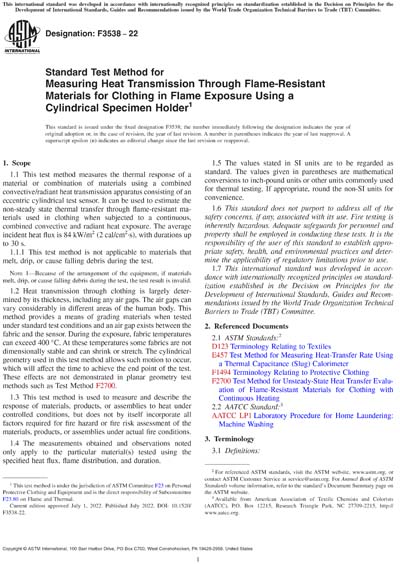Most recent
ASTM F3538-22
Standard Test Method for Measuring Heat Transmission Through Flame-Resistant Materials for Clothing in Flame Exposure Using a Cylindrical Specimen Holder
1.1This test method measures the thermal response of a material or combination of materials using a combined convective/radiant heat transmission apparatus consisting of an eccentric cylindrical test sensor. It can be used to estimate the non-steady state thermal transfer through flame-resistant materials used in clothing when subjected to a continuous, combined convective and radiant heat exposure. The average incident heat flux is 84 kW/m2 (2 cal/cm2·s), with durations up to 30 s.
1.1.1This test method is not applicable to materials that melt, drip, or cause falling debris during the test.
Note 1:Because of the arrangement of the equipment, if materials melt, drip, or cause falling debris during the test, the test result is invalid.
1.2Heat transmission through clothing is largely determined by its thickness, including any air gaps. The air gaps can vary considerably in different areas of the human body. This method provides a means of grading materials when tested under standard test conditions and an air gap exists between the fabric and the sensor. During the exposure, fabric temperatures can exceed 400 °C. At these temperatures some fabrics are not dimensionally stable and can shrink or stretch. The cylindrical geometry used in this test method allows such motion to occur, which will affect the time to achieve the end point of the test. These effects are not demonstrated in planar geometry test methods such as Test Method F2700.
1.3This test method is used to measure and describe the response of materials, products, or assemblies to heat under controlled conditions, but does not by itself incorporate all factors required for fire hazard or fire risk assessment of the materials, products, or assemblies under actual fire conditions.
1.4The measurements obtained and observations noted only apply to the particular material(s) tested using the specified heat flux, flame distribution, and duration.
1.5The values stated in SI units are to be regarded as standard. The values given in parentheses are mathematical conversions to inch-pound units or other units commonly used for thermal testing. If appropriate, round the non-SI units for convenience.
1.6This standard does not purport to address all of the safety concerns, if any, associated with its use. Fire testing is inherently hazardous. Adequate safeguards for personnel and property shall be employed in conducting these tests. It is the responsibility of the user of this standard to establish appropriate safety, health, and environmental practices and determine the applicability of regulatory limitations prior to use.
1.7This international standard was developed in accordance with internationally recognized principles on standardization established in the Decision on Principles for the Development of International Standards, Guides and Recommendations issued by the World Trade Organization Technical Barriers to Trade (TBT) Committee.
Content Provider
ASTM International [astm]






